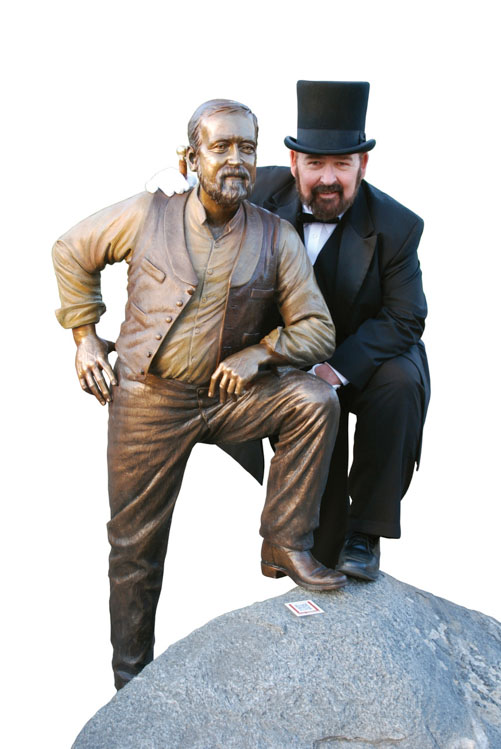The Gift of South Dakota
Subscriptions to South Dakota Magazine make great gifts!
Subscribe today — 1 year (6 issues) is just $29!
Bridges to History
Feb 22, 2021
 |
| John Timm as Governor Arthur Mellette. |
No South Dakotan alive today shook the hand of our first governor, Arthur Mellette, or stood with Valentine McGillycuddy atop Black Elk Peak. But we can still gain insight into the men and women who helped shape our state through the people who study and portray them today as historical re-enactors.
About five years ago, I asked several re-enactors for their favorite stories about the characters they have come to know so well. Here are two anecdotes that have stayed with me since the story appeared in our January/February 2017 issue, mostly because of the implications they may have had on our state’s history.
John Timm began performing as Arthur Mellette in 2005 after a historian at the Mellette House in Watertown suggested his facial features closely resembled those of the former governor, who served from 1889 to 1893.
One day, Mellette received a letter from a young man who had just graduated from law school in Mellette’s home state of Indiana. The new lawyer was inquiring about business prospects in Dakota Territory. Mellette said he could do well here and invited him to stay at the Mellette home in Watertown.
That Fourth of July, Mellette was invited to give a speech in Clark, about 30 miles west. He was unable to attend, so he asked the young lawyer to go make a speech in his place. “There was a big demand for lawyers at the time with all the homesteading and claim jumping, so the people in Clark asked him to stay,” Timm told us. “One night a terrible storm came through, probably a tornado, and the town’s sewage got mixed with the fresh water supply, setting off this great plague of cholera. As they cleaned up the town, no one remembered seeing their new attorney for quite some time. They went to his law office and sure enough, there he was — and more dead than alive.
“They sent a telegram to Mellette in Watertown that it looked like he wasn’t going to survive. Mellette took the train to Clark and brought him back in a boxcar, and he notified the young man’s family in Indiana. His dad came out by train, and between him and Mellette they nursed him back to health until he was well enough to go back to Indiana to finish his recovery.
“After he recuperated, he came back to Clark to practice law. Eventually he sent for the girl who would become his wife. Of course, we know that Mellette later became South Dakota’s first governor, and the young man he helped to save, Sam Elrod, became South Dakota’s fifth governor.”
In Rapid City, Wayne Gilbert portrayed Valentine McGillycuddy for several years through a partnership with Historic Rapid City, a preservation organization currently restoring the McGillycuddy House. McGillycuddy was the physician who tended Crazy Horse’s mortal wounds at Fort Robinson in 1877. He was among the first white men to climb Black Elk Peak in 1875 (his ashes are interred atop the mountain), was president of the South Dakota School of Mines and Technology and later mayor of Rapid City.
McGillycuddy also served as Indian agent on the Pine Ridge Reservation in the 1880s, the decade before the Wounded Knee Massacre in 1890. “He quarreled frequently with Red Cloud because McGillycuddy was trying — for good or ill — to enforce the government’s policy that the Lakota needed to be turned into farmers,” Gilbert said. “But despite that, he really was quite sympathetic to, if not aligned with, Native practices, cultures and beliefs, and at the very least tolerant of them and not willing to discourage them.
“McGillycuddy was ultimately relieved of his duties, and his replacement was new to Native culture. So when the Ghost Dance movement began he was terrified, and asked that the Army be brought to Pine Ridge. McGillycuddy was strongly against that. He said, ‘When the Seventh Day Adventists put on ascension robes and went into the mountains to await the second coming of Jesus, we didn’t call out the Army. So we shouldn’t call out the Army because these Native people are putting on ghost shirts and practicing their religion.’
“He met with Red Cloud and others and they asked him to intervene, but he told them his words didn’t have the power they once did. He did what he could, but it wasn’t enough. And it was at that point that Red Cloud said, ‘You and I never got along, but I can see now that you may have been right. You are wasicu wakan,’ loosely translated as the Holy White Man.
“Later, state historian Doane Robinson said that had McGillycuddy been the agent, or had his advice been followed, the Wounded Knee Massacre would not have occurred.”
A different governor? No Wounded Knee? We’ll never know what South Dakota might look like had either of those scenarios played out, but thanks to the re-enactors who preserve stories like these we’ll always have food for historical thought.










Comments